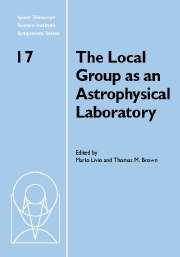 The Local Group as an Astrophysical Laboratory
The Local Group as an Astrophysical Laboratory Published online by Cambridge University Press: 12 May 2010
Our Milky Way Galaxy is a typical large spiral galaxy, representative of the most common morphological type in the local Universe. We can determine the properties of individual stars in unusual detail, and use the characteristics of the stellar populations of the Galaxy as templates in understanding more distant galaxies. The star formation history and merging history of the Galaxy is written in its stellar populations; these reveal that the Galaxy has evolved rather quietly over the last ∼10 Gyr. More detailed simulations of galaxy formation are needed, but this result apparently makes our Galaxy unusual if ∧CDM is indeed the correct cosmological paradigm for structure formation. While our Milky Way is only one galaxy, a theory in which its properties are very anomalous most probably needs to be revised. Happily, observational capabilities of next-generation facilities should, in the foreseeable future, allow the acquisition of detailed observations for all galaxies in the Local Group.
Introduction: The fossil record
The origins and evolution of galaxies such as our own MilkyWay and of their associated dark matter haloes are among the major outstanding questions of astrophysics. Detailed study of the zero-redshift Universe provides complementary constraints on models of galaxy formation to those obtained from direct study of high-redshift objects. Stars of mass similar to that of the Sun live for essentially the present age of the Universe and nearby low-mass stars can be used to trace conditions in the high-redshift Universe when they formed, perhaps even the ‘First Light’ that ended the Cosmological Dark Ages.
To save this book to your Kindle, first ensure [email protected] is added to your Approved Personal Document E-mail List under your Personal Document Settings on the Manage Your Content and Devices page of your Amazon account. Then enter the ‘name’ part of your Kindle email address below. Find out more about saving to your Kindle.
Note you can select to save to either the @free.kindle.com or @kindle.com variations. ‘@free.kindle.com’ emails are free but can only be saved to your device when it is connected to wi-fi. ‘@kindle.com’ emails can be delivered even when you are not connected to wi-fi, but note that service fees apply.
Find out more about the Kindle Personal Document Service.
To save content items to your account, please confirm that you agree to abide by our usage policies. If this is the first time you use this feature, you will be asked to authorise Cambridge Core to connect with your account. Find out more about saving content to Dropbox.
To save content items to your account, please confirm that you agree to abide by our usage policies. If this is the first time you use this feature, you will be asked to authorise Cambridge Core to connect with your account. Find out more about saving content to Google Drive.